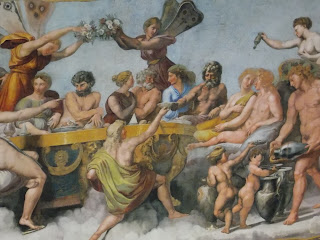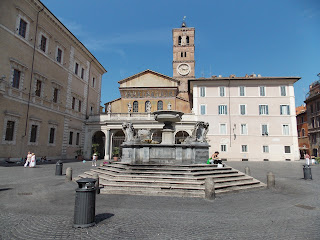It’s our last day in Rome! The time has flown by amazingly
fast!
In beginning this blog I see that I missed one of the
important stops of yesterday… The Gesu.
The foremost Jesuit church in Rome was built between 1568 and 1575. It was built as an overwhelming display that
would challenge every one of your senses as you entered. We were directed to sit by our professor, not
the usual protocol of the trip, but we were soon to find out why. At the same time each day, the church has a
magnificent performance of song, spoken word, dramatic lighting, and mechanical
effects. The result was quite stunning,
and more than a bit overwhelming. I can only imagine the impact on those that
can understand Italian that have come there to worship.
On our last day we compared churches designed by Bernini and
Borromini, San Andrea Al Quirinale and San Carlo Alle Quattro Fontane. Both of these churches were designed in small
spaces, and we could compare the two from the standpoint of design, and use of
that design to create the illusion of a bigger space. San Andrea, designed by
Bernini is made to look larger by the skilled placing of light, color choices
in marble, and ceiling decoration that leads the eye. San Carlo, designed by Borromini features
convex and concave surfaces in the ceiling, as well as a series of geometric
shapes that create the illusion that the ceiling is taller than it’s actual
height.
Our last stop of the trip is the Palazzo Barberini. At this
point, we have all taken in so much, that it is hard to comprehend any more.
The Palazzo Barberini is one of the grandest palaces in Rome, built for the
Barberini pope Urban VIII in 1624. Both Bernini and Borromini were a part of
the design of the palace. The palace is now home to what is considered the most
important of Italian Baroque paintings.
The most outstanding of the paintings that we saw was the ceiling fresco
in the salon by Pietro da Cortona. This fresco is located in a room that would
have been available for access by many people, and the fresco was designed to
make a statement of power.
Having the room to ourselves, we were able to lie on the
couches to get a more comfortable view of the ceiling. The imagery includes
Divine Providence crowning with the laurel wreath of Immortality, along side
the family arms of the Barberini, and the family crest symbol, the honeybee.
These symbols represent the triumph of pope urban over lust and intemperance.
Our time in Rome has concluded and everyone is excited for
the return trip, or for further travel. The sights that we have seen may take
months to fully process, and I know the memories will last a lifetime. Someday, I hope to bring my family, and
possibly my own group of students to Rome to share what I have learned these
past two weeks.
Arrivederci Roma!

































